OSLO, Norway—We’re making our way back to the hotel after a rainy day of driving and otherwise being indoctrinated to the key elements of the all-new, all-electric 2020 Mercedes-Benz EQC 400 4Matic. As the traffic slows, we get a chance to glance at the cars passing by us on their way out of Oslo’s city center.
EVs of all shapes and battery sizes fill the lanes. The usual, more affordable suspects abound: Nissan Leafs, VW e-Golfs, Renault Zoes, and even some Mitsubishi i-MiEVs (no, we aren’t kidding). But of far more importance to the contingent of Benz engineers, marketers, product planners, and support personnel dispatched to Norway’s ancient capital to preach the EQ gospel to us are the significant number of Jaguar I-Pace and Audi e-tron SUVs already on the road. And then there are the Teslas. So many Teslas. We once read that Norway is the per-capita capital of Tesla sales, and we’re going to go out on a limb and say that’s true. (And, yes, the Norwegian government subsidizes EV sales, so it’s not exactly the free market at work.)

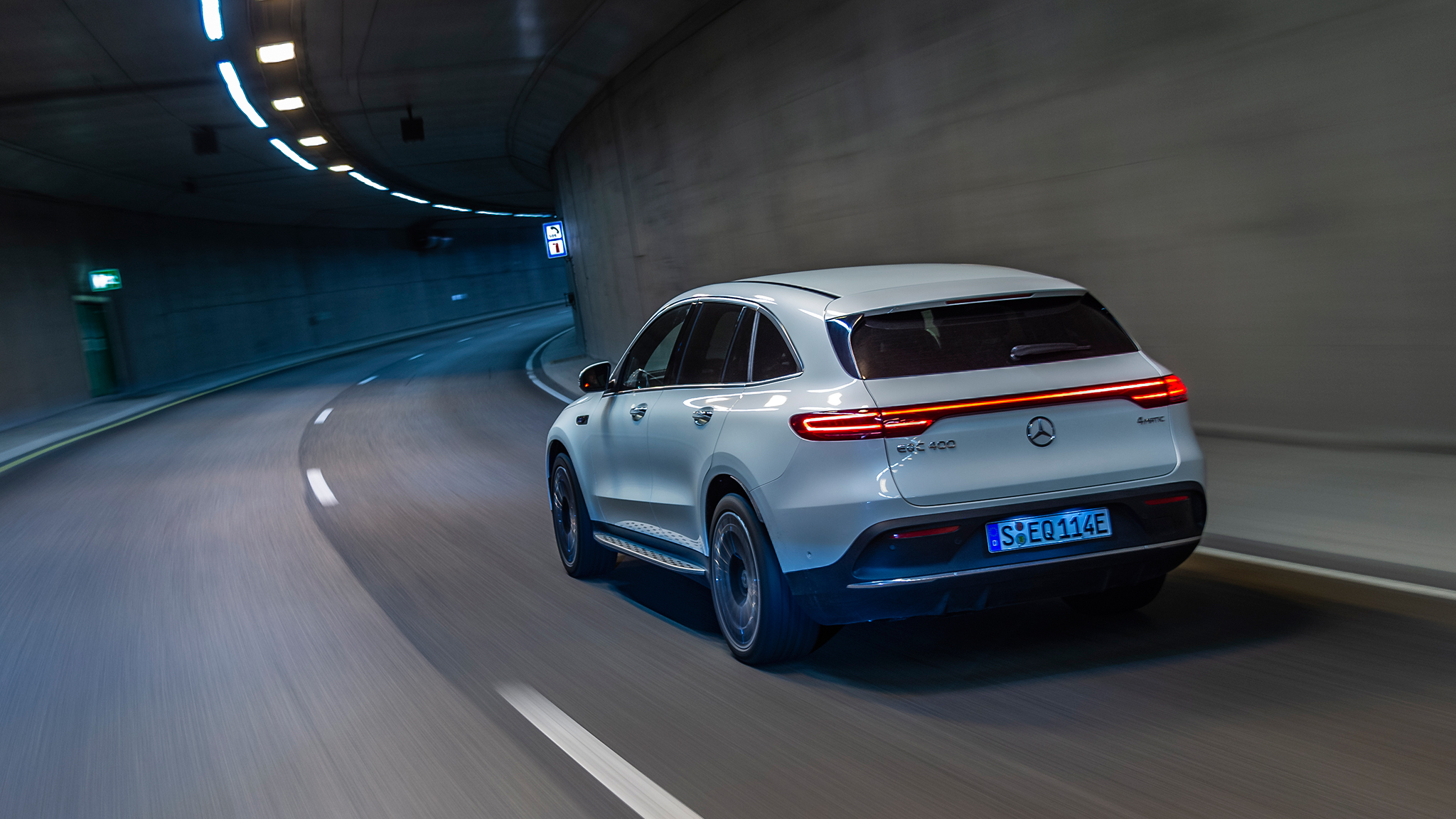
What Is an EQC?
The 2020 EQC’s launch is part of a three-pronged electrification strategy Benz is rolling out across its lineup, consisting of 48-volt mild-hybrid systems as seen in the new CLS-class, plug-in hybrids such as the GLC350e 4Matic, and the all-electric powered EQ models.
While it’s related to the Mercedes GLC-class (it shares about 15 percent of its components with Benz’s compact crossover, as well as rides on the same 113.1-inch wheelbase) and is built on the same production line, the 2020 Mercedes EQC400 is in essence a one-off design. The automaker is developing a dedicated platform for its coming new EQ models, so for this generation at least, a sizeable chunk of the EQC’s engineering will be unique to the vehicle.
That’s not to say the EQC is revolutionary. Like most all-electric vehicles on the road, the EQC’s 80-kWh, lithium-ion battery pack—all 1,437 pounds of it divided into two bundles containing 384 total cells—is located in the floor, between the axles. Although Benz wouldn’t comment publicly about the EQC’s overall range in U.S. measurements, the scuttlebutt out of Oslo is that it will come in somewhere slightly north of 200 miles to a full charge. EQC director of development Michael Kelz quoted a real-world number of around 360 or so kilometers, which translates to around 223 miles to a charge, or what you can probably expect from the EPA. Produced in Germany by the Daimler-owned company Deutsche Accumotive, the battery is estimated to require 10 hours or so to charge from 10 percent to full using a wall-box type AC outlet, or about 40 minutes from 10 to 80 percent full via a DC, 400-volt fast-charging setup
Putting the EQC in Drive
At a soggy, foggy airfield outside of Oslo, we had a chance to put the electric hammer down in order to get a sense of how much off-the-line punch the EQC’s battery pack can deliver. There’s a lot of crossover to motivate, some 5,500 pounds in all. But give it the juice and Benz says the EQC can do the electric boogaloo from zero to 60 mph in about 4.9 seconds. We wouldn’t dispute that number after our test passes.

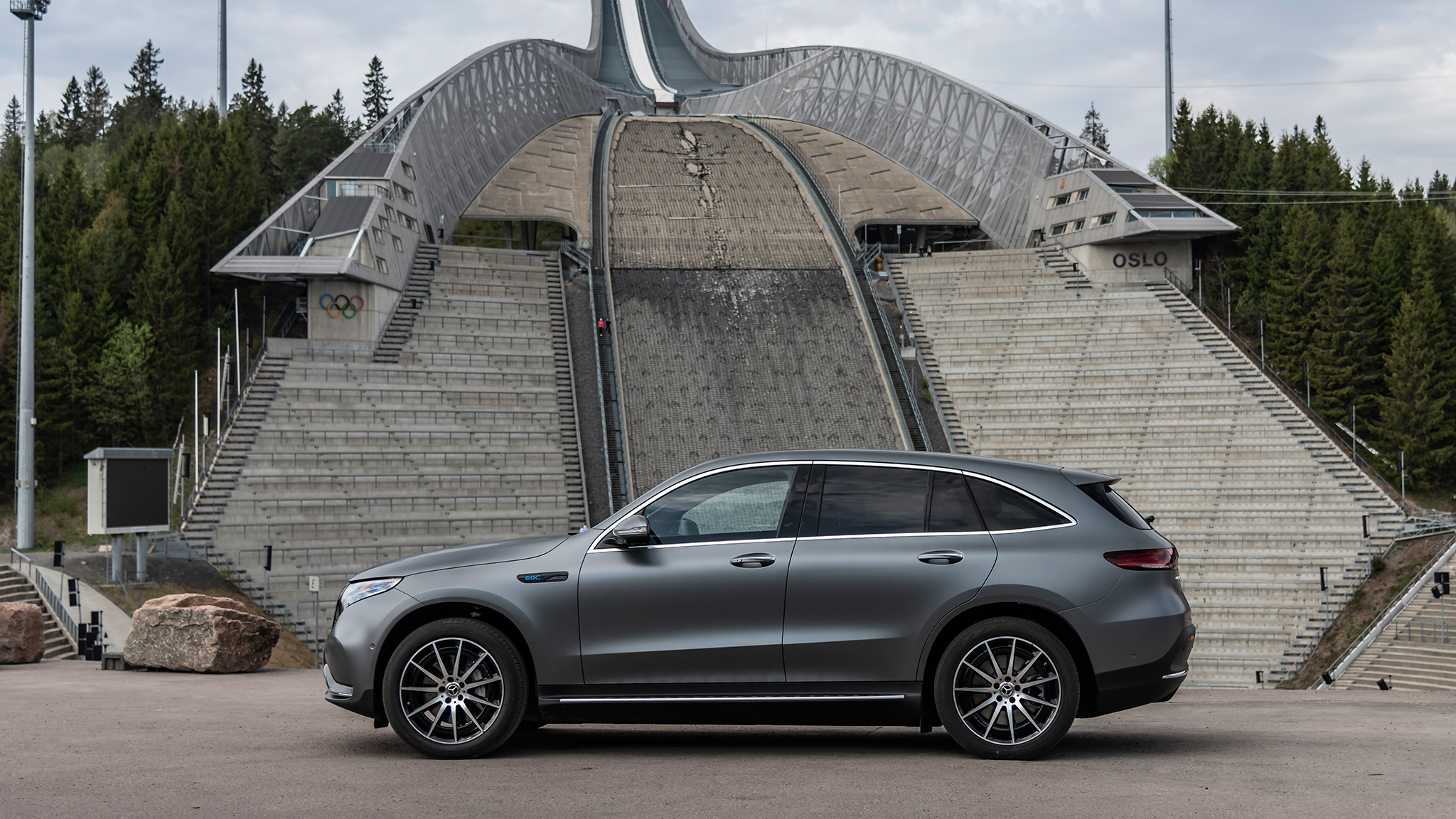
Also like many other all-electric offerings, the EQC utilizes two asynchronous electric motors to spin the wheels, one at each axle. Overall system output is rated at 402 horsepowers—if you’re saying it as a German, it’s plural—and 564 lb-ft of torque. While the motors put the 4 in 4Matic, the EQC is set up as more of a front-drive vehicle: The front drivetrain handles most of the light- and medium-duty lifting, with the rear supplying the extra punch under heavy loads or when traction conditions warrant. It’s all been engineered down to the hundredths of milliseconds when the system determines that it needs both motors to start spinning together, and there’s virtually no way you’re going to sense it when they do.
During our slow go around Oslo’s forested environs, the EQC400 (we asked and the 400 means, well, nothing) feels much like any other EV. There’s the zero to 100 percent torque burst off the line, but back off the accelerator and it’s smooth sailing. The variable electric rack and pinion steering firms up at speed, and when we found some mildly rough roads through the Norwegian woods, the four-wheel independent suspension working them over without much effort.
Features Unique to the EQC
One of the EQC’s signature features is its energy recuperation system, which is operated by the steering wheel paddles. The five modes (D–, D-, D, D+, D Auto) range from slow you down as soon as you lift off the pedal (D–) to coasting (D+). Pop it into D Auto, and the car’s Eco Assist system sets to work optimizing the energy delivery and regeneration on your route ahead using data from the radar and other systems, including the navigation. You may have heard the term “one-pedal driving” when it comes to EVs, which is in effect using the car’s energy recuperation system as the brake while it also charges the battery. With the EQC you can go one better and do some two-paddle, no-pedal driving. In limited situations, we were able to cycle back and forth through the D modes to modulate the EQC’s momentum, especially in downhill stints once that two-and-a-half tons of mass got moving.

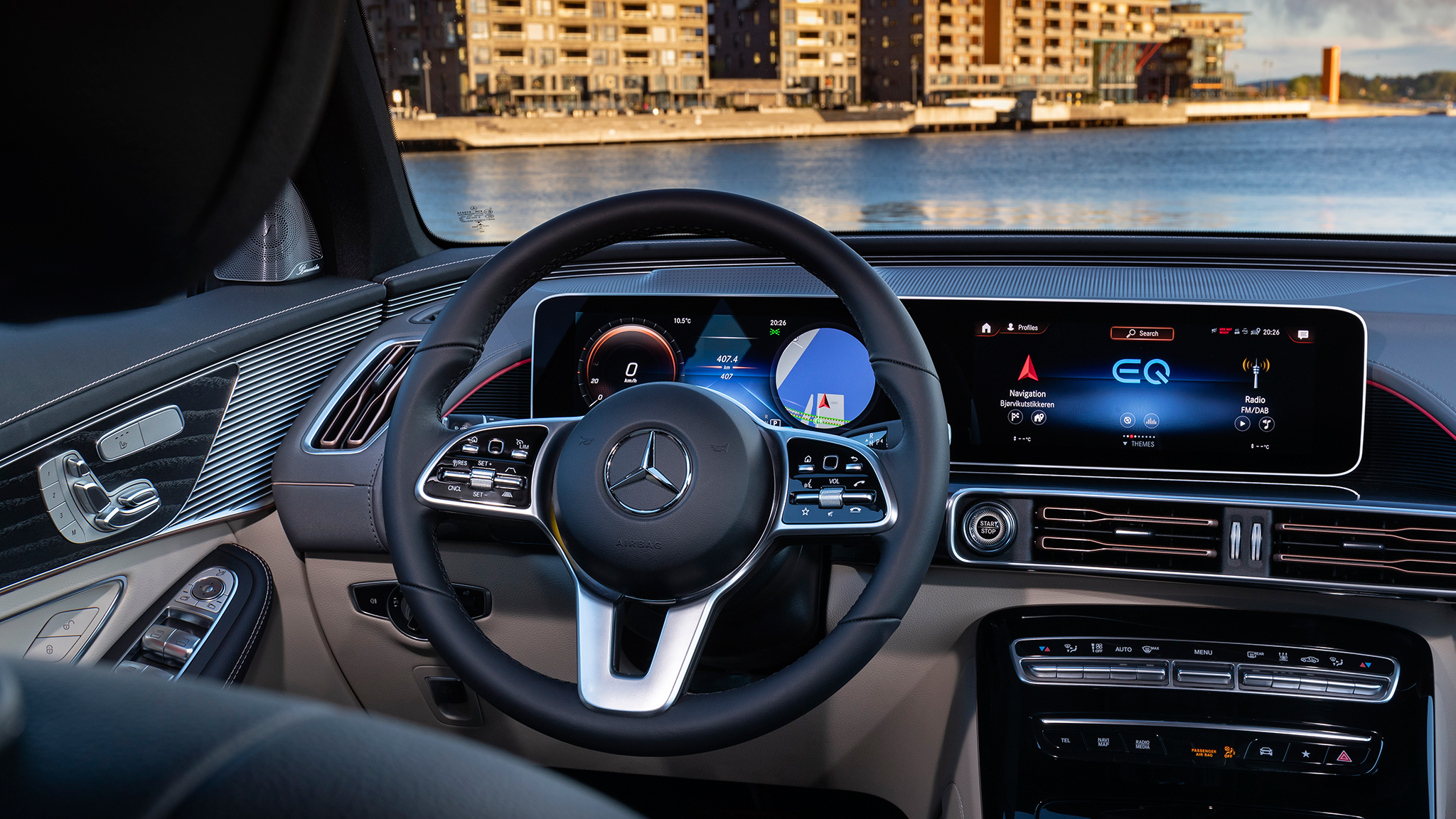
We also had a go using one of the other EQC-only features, Max Range, available as part of Benz’s now familiar Eco, Comfort, Sport, and Individual mode-selection system that adjusts factors including steering feel, power modulation, and stability control. Flip it into Max Range with D Auto also selected, and the car’s nerve center ties together every energy-maximization trick in the EQC’s extensive playbook. Press down on the accelerator in Max Range and you’ll hit a detent in the travel. Keep your foot there, and you’ll start maxing out.
What the EQC Is Like on the Inside
All of these parlor tricks are accessed through and otherwise displayed by the automaker’s new MBUX infotainment system and high-definition digital instrument-panel setup. Toggle over to the EQ tab by using the touchpad in the center console or the touchscreen, and you can geek out over the energy usage graphs. If you’re feeling frisky, you can use the MBUX’s “Hey Mercedes” voice-command prompt to access system features. Most of this isn’t new to the EQC, but it packages up well given the vehicle’s high-tech theme. Mercedes was also keen to call out its Mercedes Me app that will allow you to access vehicle functions or plan a multiple-charge-spot road trip with minimal downtime. Once you do, you can push the trip to the car’s nav system.

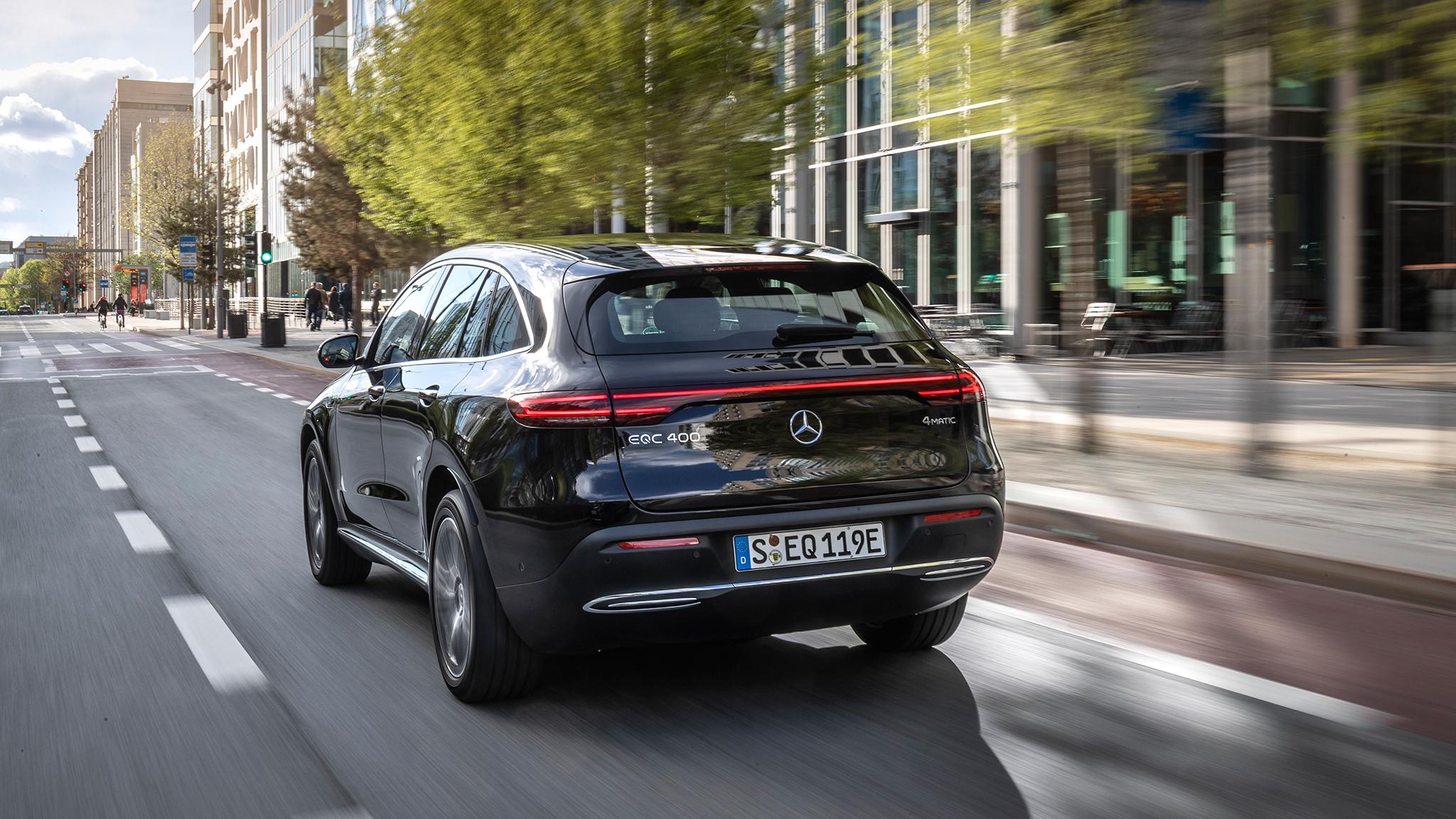
As is the case with MBUX, the EQC will also be available with much of the latest in Benz safety tech, including evasive steering assist, an updated self-parking feature, and advanced pedestrian and emergency crash-avoidance systems.
Given its compact dimensions, the EQC isn’t super spacious in the cockpit, but the seating and steering column controls make it easy to adjust things to your liking. Head and legroom are acceptable in the back, as are cargo space and the fold-flat 40/20/40 split rear seat.
EQC Is Electrified Luxury
Mercedes will also be pushing a higher-end luxury approach with the EQC. Lots and lots of work was done to minimize driveline noises and other unwanted sounds from reaching your ears. To be clear, although you can sport it up a bit, this not a performance EV. It’s no slug dynamically, but far more effort was expended on optimizing the ride for customers looking for more of an isolated, composed EV.

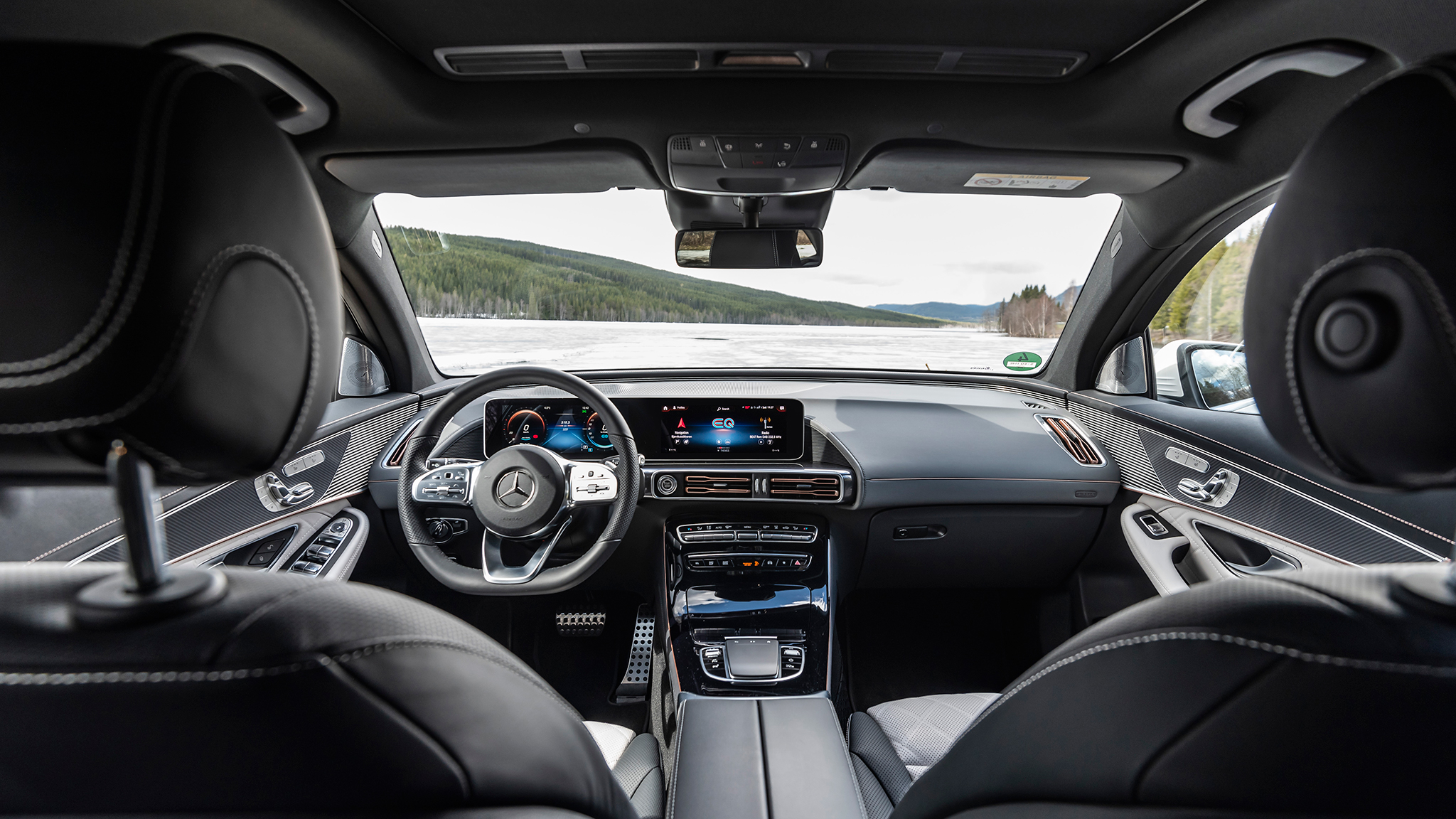
The luxe theme is also extended to the cabin. We sampled two models that showcased the crossover’s slick, wraparound cockpit, elegant wood trim, copper-tinged minimalist venting, and tasteful lighting and stitching accents. You can also really do it up with one of Benz’s Designo interior treatments. There weren’t a lot of chances taken with the EQC’s exterior, but several aerodynamic enhancements were made in a bid to further optimize range. Special lighting flourishes, two grille options, and multiple wheel-and-tire packages in 19- or optional 20-inch sizes will help the EQC stand out some.
So, no, the Mercedes EQC isn’t going to dramatically shake up the all-electric crossover market when it gets here next year at a starting price likely close to that of the Audi e-tron, which checks in at around $75,000 before tax incentives. But what it will do is offer yet another first-rate option for buyers of a certain means who are ready to take the plunge into an alternative-propulsion future—one that’s already being realized to a certain extent on the mean streets of Oslo.
2020 Mercedes-Benz EQC Specifications |
|
| ON SALE | Spring 2020 (est) |
| BASE PRICE | $75,000 (est) |
| DRIVETRAIN | 80-kWh lithium-ion battery pack, 2 asynchronous electric motors; total system output, 402 hp, 564 lb-ft |
| RANGE | 210–220 miles (est) |
| TRANSMISSION | 1-speed automatic |
| LAYOUT | 4-door, 5-passenger, dual-motor, AWD SUV |
| EPA MILEAGE | 80 MPGe (combined, est) |
| L x W x H | 187.4 x 82.5 x 63.9 in |
| WHEELBASE | 113.1 in |
| WEIGHT | 5,500 lb (est) |
| 0–60 MPH | 4.9 sec (est) |
| TOP SPEED | 112 mph |
